
views
X
Research source
Overweight cats also tend to have a shorter lifespan and becomes less energetic and playful as they age. With the right approach, you can help your obese cat lose weight and ensure she is around for years to come.
Adjusting Your Cat’s Diet
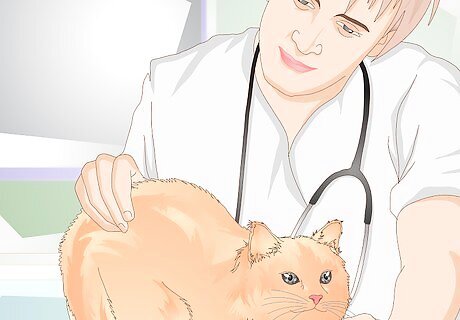
Get your cat checked by your vet. Though it may be tempting to switch your cat’s diet right away without going to the vet, this could create a serious health issue for your cat called hepatic lipidosis. This is a life-threatening form of liver disease that can develop in obese cats who have a drastic shift in their diet and do not eat properly. So it is a good idea to bring your cat to your vet for a check-up and a consultation before you put her on a weight loss plan. Your vet will do a physical exam of your cat to determine her level of obesity. She may also do some diagnostic testing on your cat to ensure she does not have any underlying diseases or health issues that could affect her weight loss. Once your cat is cleared of other medical issues, your vet should discuss your cat’s weight loss options with you. One common health issue for overweight cats is diabetes. If your vet determines your cat is diabetic, she will likely recommend a nutritional program to help your diabetic cat lose weight safely. Your cat may also need insulin injections, which can be discussed in more detail with your vet.

Determine your cat’s target weight. To figure out how much food you should give your cat to help her lose weight, you will first need to determine your cat’s target weight with the assistance of your vet. Your vet will use the results of the physical exam and an ideal body weight formula to come up with a target weight for your cat. Your cat’s ideal weight will also be based on her body size and her build. The average domestic cat should weigh around 8-10 pounds or 3.6-4.4 kg. Depending on how obese your cat is, your vet may recommend a target weight for your cat that is higher than the average weight for her size and build. If your cat weighs 18 pounds, for example, her ideal weight may be around 10 to 12 pounds. But your vet may suggest you aim for a goal weight of 15 pounds so it is realistic and manageable for both you and your cat. Once your cat reaches a realistic goal weight, your vet may recommend that you work towards a lower body weight. Your cat should lose weight gradually over an extensive period of time. If her goal weight is 15 pounds and she currently weighs 18 pounds, for example, you should get her to lose one pound a month for three months. Stretching out her weight loss so it occurs gradually will ensure she does not develop liver issues or other health problems.
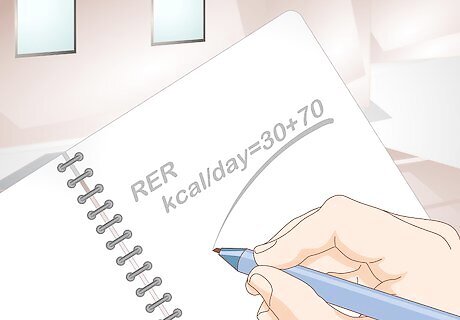
Figure out your cat’s ideal calorie intake. To determine how many calories your cat should consume every day, you will need to calculate your cat’s resting energy requirement (RER). This is the amount of calories she needs to stay healthy when she is not doing any physical activity. You can use the following formula: RER in kcal/day = 30 (body weight in kilograms) + 70. You will need your cat’s body weight in kilograms to calculate her calories per day. To help your cat lose weight, you should feed her about 80% of the RER or multiple her RER by 0.8. For example, if her ideal weight is 10 lbs, you should try to have her eat 210 calories a day. If her ideal weight is 12 lbs, she should have 230 calories a day. Keep in mind the daily calorie intake should be used as a guideline. Do not underfeed your cat, as this can lead to health issues. Your vet may also give you more specific recommendations for your cat’s diet.
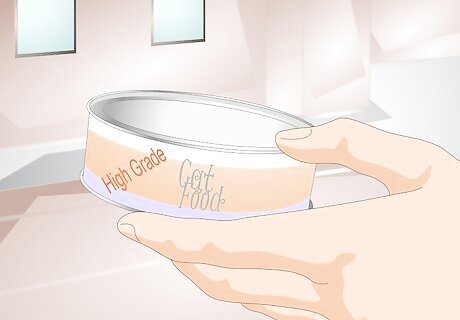
Look for canned high quality food for your cat. For many overweight cats, canned wet food can be an effective way to lose weight. Many cats enjoy wet food over dry food and the canned wet food allows you to control how much food you give your cat every day. Look on the canned food labels for the calorie count and give your cat only enough food to fulfill her ideal calorie intake for the day. Canned wet food is also better than dry food because it does not allow your cat to nibble on food all day long, which often happens when your cat is bored or eating just to eat. Aimless eating can often lead to further weight gain. Your vet may be able to recommend high quality brands of wet food that you can give your cat. If your cat has diabetes, your vet may be able to recommend a food brand that contains ingredients that will not irritate your cat’s diabetes.
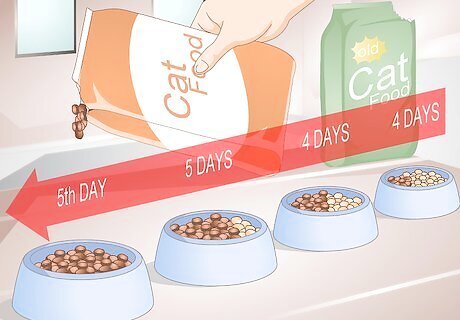
Transition your cat slowly into her new diet. To avoid freaking out your cat’s system, you should allow for one to two weeks to transition your cat into her new diet. Most cats will adapt fairly well to a new diet as long as they are eased into it. Begin by mixing ¼ of her new diet food with ¾ of her old food for two to four days. Then, increase this to ½ of her new food and ½ of her old food for another two to four days. Increase this again to ¾ of the new food and ¼ of the old food for three to five days. After five days, you can switch her completely to her new diet food only. You should also create a feeding schedule where you feed your cat two to three times a day at the same time every day. This will help her get used to her new food and help her body adapt to her new food intake. If you have other pets, you should feed your overweight cat separate of the other animals so you can monitor her food intake. To encourage your cat to eat her new food, you can add a small amount of flavoring such as ketchup and salmon or tuna juice. You can also try warming up the food so it is warm and appetizing to her.
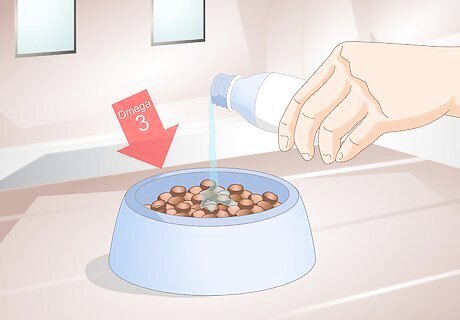
Add dietary supplements to your cat’s diet. Feeding your cat less food will also mean she is going to get fewer nutrients. You should give your cat supplements to ensure she stays healthy and active. Your vet can recommend several supplements you can give your cat, such as omega-3 fatty acid supplements and a multi vitamin. If your cat is diabetic, your vet may also give you detailed instructions on how and when to give your cat insulin injections. Some diabetic cats do so well on an adjusted diet that they eventually no longer need insulin injections. You should monitor your diabetic cat closely and bring her to the vet before taking her off her injections.
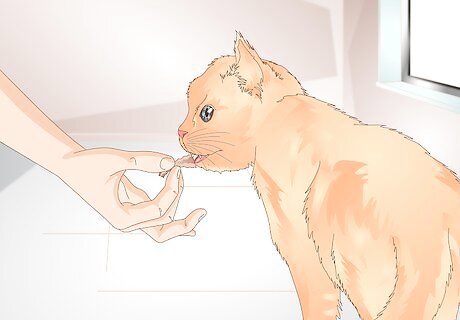
Give your cat low calorie treats. Your overweight cat likely gained some of her weight from too many high calorie treats being thrown her way. Avoid giving your cat table scraps from your meals, as these are often high in fats and sugars. In general, treats should make up no more than 10% of your cat’s daily calorie intake. Low calorie treats include air-popped popcorn that is unsalted and unbuttered, pieces of broccoli or cooked green beans, and baked or frozen canned diet food. You can slice up canned food and bake the slices until they are crispy or freeze them as a small snack for your cat. You can also look for low calorie commercial treats for your cat. However, check the ingredients to ensure the treats are not high in sugar, fat, or empty calories. If possible, you should try to substitute a treat with a kind act, like grooming your cat or letting her play with a new toy. Often, cats will respond just as well to your undivided attention as they would to a treat.
Getting Your Cat to Exercise
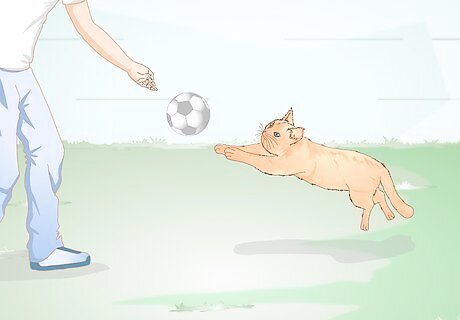
Play with your cat. Participate in your cat’s weight loss by playing with her at least once to twice a day. Use her toys to initiate a 30-minute play session with your cat where you are running around together inside. You may want to also motivate her by giving her a low calorie treat after each play session as a reward. Get your cat to chase around her toys and chase you when you are holding her toys. You may want to change up her toys so you use a different toy every time you play with her.
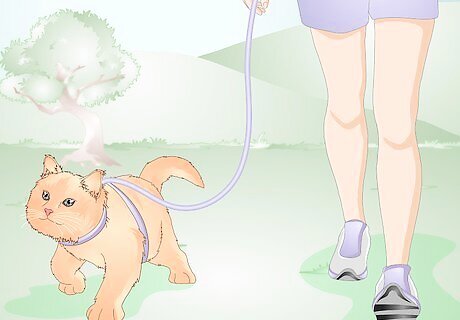
Try walking your cat on a leash. Some cats enjoy going for a walk on a leash and some cats do not. The only way to determine where your cat stands is to try to walk her on a leash around the block. It may be challenging for some cats, especially if they are primarily indoor cats. But going for a walk once a day can be a good form of exercise for both you and your cat.
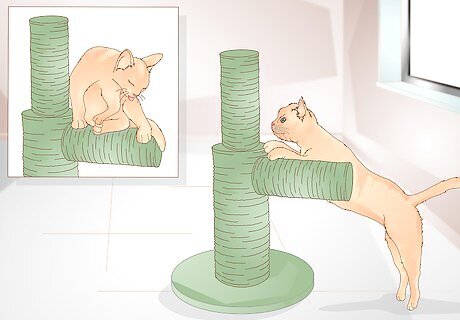
Put climbing and scratching posts in your cat’s space. Give your overweight some motivation to move around and exercise when she is indoors by putting in climbing and scratching posts. The posts should have multiple levels with different scratching areas. This will force your cat to climb and stretch to get to certain areas on the post. The posts should also have platforms that your cat can sit on and rest on, as most cats enjoy having multiple vantage points in a space. You may want to put your cat’s toys on different areas of the post to encourage her to climb and stretch for the toys.

Create interactive toys with toilet paper rolls and boxes. You can also encourage your cat to get moving by making simple, interactive toys. Stack several toilet paper rolls on top of each other to form a pyramid and hide low calorie cat treats in the rolls. You can also cut holes in a cardboard box and stick treats in the box that your cat has to move, shake, and toss to access. These kind of interactive toys can encourage your cat to play and exercise throughout the day. They are especially useful for cats who are indoor cats and do not spend much time playing or running around outside.
Maintaining Your Cat’s Weight Loss
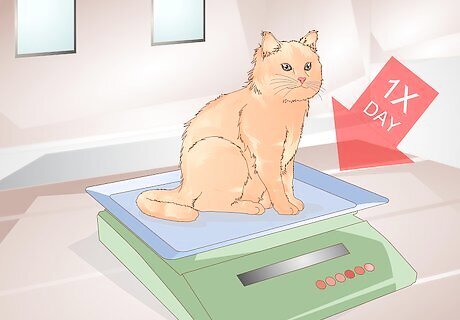
Weigh your cat regularly. You should weigh your cat on the same scale at the same time of day once a day. You may need to use a smaller sized scale to weigh your cat to ensure the numbers are accurate. Note your cat’s daily weight in a log and pay attention to how much weight your cat is losing every week or every month. The weight loss should be consistent and gradual. When recording your cat’s weight, you should also pay attention to any plateaus your cat hits, where she appears stuck at a certain weight. This is bound to happen. The plateau should drop over time as long as you continue with her diet and exercise program.
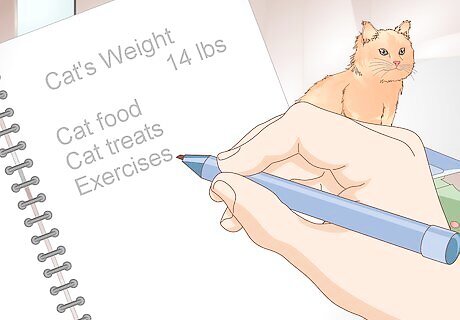
Monitor your cat’s progress in a written log. Keeping track of your cat’s weight loss will give you a better sense of the effectiveness of her diet and her level of exercise. Write down her food intake, including any treats, her level of exercise and her weekly weight. You should make sure your cat is only eating within her ideal calorie intake and that her weight continues to go down at a steady pace. If she starts to gain weight, you may want to consider her diet and if anyone is cheating in your household by giving her extra treats or extra food. Another good way to monitor your cat’s progress is to take before and after pictures of your cat. You can do this at the beginning of her diet and then take pictures every month to monitor her progress. Make sure you are also talking to your vet on a regular basis and reporting your cat’s weight loss progress to your vet. Your vet should be part of the monitoring as this will allow her to pick up on any possible health issues or problems in your cat as she loses weight.
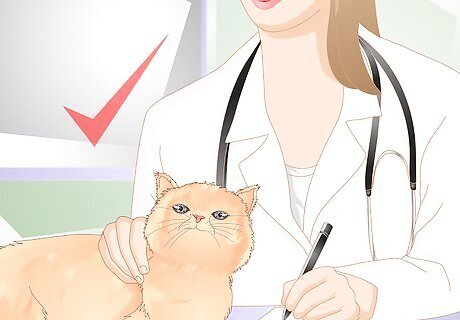
Adopt a long term diet and exercise plan for your cat. You should make monthly appointments with your vet to ensure your cat is losing weight in a healthy and sustainable way. Once she hits her goal weight, you should adopt a long term plan so she keeps the weight off. You can increase her food intake slightly but you should make sure she is still exercising and eating healthy. You should also make sure she does not gain weight consistently for two weeks or gain more than 3% of her weight within one week, as these are indicators that she may be headed back to obesity. Instead, focus on making her diet and exercise a sustainable and normal thing for her.




















Comments
0 comment